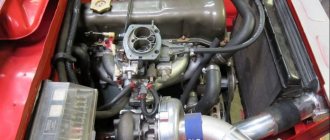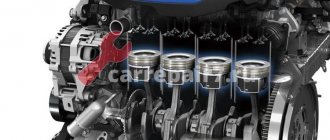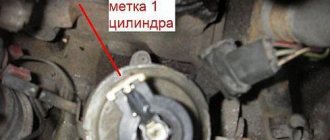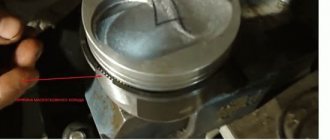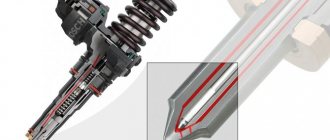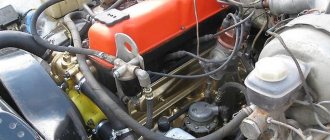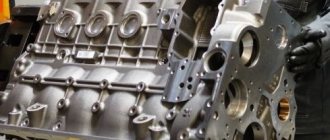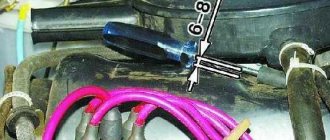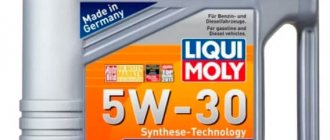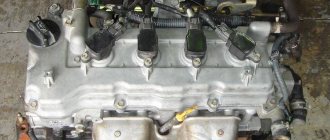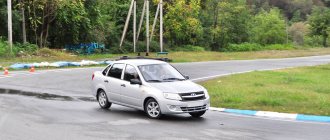Array ( [DATE_ACTIVE_FROM] => 11/25/2020 04:50:00 [~DATE_ACTIVE_FROM] => 11/25/2020 04:50:00 [ID] => 509832429 [~ID] => 509832429 [NAME] => YaMZ installation 236 on ZIL 131 [~NAME] => Installation of YaMZ-236 on ZIL 131 [IBLOCK_ID] => 33 [~IBLOCK_ID] => 33 [IBLOCK_SECTION_ID] => [~IBLOCK_SECTION_ID] => [DETAIL_TEXT] => Today YaMZ -236 continues to remain relevant in comparison with many other diesel engines and therefore continues to be used in the design of the ZIL 131. Produced since the times of the USSR. It is a 4-stroke, 6-cylinder and 12-valve unit and is used in different types of equipment: from tractor and ending with passenger cars. From here we can conclude that this engine has an important feature - versatility. But in addition, it is characterized by a high degree of reliability and "failure-free operation". This article will discuss the installation of the YaMZ-236 on the ZIL 131, since the sequence of actions when replacing it, it is not obvious to all car owners.
Production of YaMZ-236
The Yaroslavl Motor Plant (Avtodiesel) has been producing serial diesel engines since the distant year 1958. This year there was a reformation of the organization that produced cars, and even earlier, buses and trolleybuses. Initially, the new plant continued to produce diesel engines that were used to power previously assembled trucks. Initially, during the development of production processes, there was active development of new types of engines. This led to the fact that over time the plant began to produce engines for various purposes with powers ranging from 180 to 810 hp. And in the early 60s of the last century, the production of YaMZ engines began, among which was the YaMZ-236. The engines were easy to assemble, making production rates quite impressive. The resulting products could be installed on special equipment and industrial equipment. The new engine turned out to be so productive and reliable that it immediately became the only one and standard for all cars in the USSR, and after more than half a century it is still produced at the native engine plant. Car owners are surprised when they learn that the engine is actually manufactured in dozens of types of modifications. But despite the high performance in a number of basic characteristics, the YaMZ-236 engine is no longer included in the list of the best in the world. In terms of performance, it can be easily compared with Chinese devices. At the same time, in terms of reliability and ease of maintenance, it is still ahead of not only imported brands, but also well-known devices from developed countries.
Is it possible to install a Yamz-236 and even with a turbine on a Zil-4331
Questions can only be asked after registration. Please login or register.
please tell me how to correctly install a Yamz-236 engine with a turbine on a Zil-4331 and is this possible and what is needed for this
Has anyone really done something like this?
A turbine is not needed there. The rear axle gearbox is still “not enough” to transmit the received power. And the YaMZ-236 on this machine is the standard option—at one time they came with them from the factory.
and how will it behave with 20-23 tons of cargo if it is with a trailer?
To do this, you need to install a RABO bridge. Strengthen the rear springs. For a trailer, 12-15 tons. And the gearbox must have a divider. Very desirable.
A turbine is not needed there. The rear axle gearbox is still “not enough” to transmit the received power. And the YaMZ-236 on this machine is the standard option—at one time they came with them from the factory.
I read somewhere on the Internet that the Yamz-236A was installed on the Zil-541730 truck tractors, but since 1999 they began to install the Yamz-236NE with a power of 230 hp. therefore the gearboxes can withstand this power
A turbine is not needed there. The rear axle gearbox is still “not enough” to transmit the received power. And the YaMZ-236 on this machine is the standard option—at one time they came with them from the factory.
I read somewhere on the Internet that the Yamz-236A was installed on the Zil-541730 truck tractors, but since 1999 they began to install the Yamz-236NE with a power of 230 hp. therefore the gearboxes can withstand this power
I have seen these, but only with RAB bridges. Rubber-300/508. I have also seen them with YaMZ-238. Gearbox - YaMZ 8-mortar. The ZiLovsky bridge is not bad, but still rather weak. Note that there are 2 of them on the ZIL-133GYA and people complain about them, they try to replace them with KAMAZ ones
It seems to me that in most cases they are replaced due to a shortage of spare parts, but about the Slave Bridge, I agree with you
An interesting topic, I’m also planning to install Yamz on 4331, but I don’t have enough time yet.
They advise installing it without a turbine, but I want it to be more powerful
The turbine is an extra hassle. YaMZ236 is a very reliable internal combustion engine, and with a turbine, the engine will wear out significantly more.
They advise installing it without a turbine, but I want it to be more powerful
what work will zil perform
They advise installing it without a turbine, but I want it to be more powerful
what work will zil perform
It is planned that it will work intercity, I plan to use transportation of consumer goods with a trailer in the future
They advise installing it without a turbine, but I want it to be more powerful
what work will zil perform
It is planned that it will work intercity, I plan to use transportation of consumer goods with a trailer in the future
Guys, happy holiday to all of you! On the topic: type in a search engine Zil with a MAZ engine. There is a lot of interesting information in this article.
How did I go to the address? )))))))))))))))))) interesting topic. )))))))))))))) I myself was sick of this idea, and even found such options on the Internet, but then I decided to abandon it, a 645 engine can cope with twenty, and if you transport 25 or more tons, Then you can plug in a KAMAZ one. ))))))))))))))))
ZIL - drive your dream!
Few people praise 645.
I don’t agree here, and I think how you treat the car is how it serves. pour good oil and diesel fuel and he will walk. ))))))))))))))))
ZIL - drive your dream!
atmospheric?! and there’s no point in exchanging shit for soap, there’s a lot of rework. and the result is + 10 mares and 70 Newtons, and in the 5-mortar box the numbers are not very well chosen. the unpretentiousness of Yamz is an undeniable plus! but I think that if you bother, it’s only with the YaMZ 236BE and the KAMAZ gearbox. and a good zilok and smear can give you a head start. https://trucks.auto.ru/artic/used/sale/2122018-3a5a7a.html
ZIL - drive your dream!
I don’t agree here, and I think how you treat the car is how it serves. pour good oil and diesel fuel and he will walk. ))))))))))))))))
That's how to say it. Why do most 645s remove and install other diesel engines? At least that’s what they do here. The jumpers in the block often burst (they are weak). I now have two 4331 with 645 internal combustion engines. I will install an internal combustion engine from the Urals on one. And on the other I am thinking of installing one from a MAZ YaMZ-236.
I don’t agree here, and I think how you treat the car is how it serves. pour good oil and diesel fuel and he will walk. ))))))))))))))))
That's how to say it. Why do most 645s remove and install other diesel engines? At least that’s what they do here. The jumpers in the block often burst (they are weak). I now have two 4331 with 645 internal combustion engines. I will install an internal combustion engine from the Urals on one. And on the other I am thinking of installing one from a MAZ YaMZ-236.
Characteristics of the YaMZ-236B motor
Having looked at the detailed characteristics of the YaMZ-236M2-1, it becomes clear why owners of the ZIL 131 want to install it in their car. YaMZ-236 does not emit harmful substances and does not harm the environment. The manufacturer claims zero environmental parameters, which makes the naturally aspirated engine one of the weakest in the power range of YaMZ engines. The manufacturer states that this parameter for engines in the YaMZ-236A modification is 195 hp, and the minimum for the deformed YaMZ-236G is 150 hp. The devices are used as a motor for vehicles that drive both on asphalt roads and off-road. These parameters, as well as a number of other significant characteristics, made it possible to use the six-cylinder YaMZ 236 in trucks.
New against the background of old
Against this background, the ZIL-433180 truck, created with minimal effort, one might say, from improvised means, is distinguished by the best specific indicators, for example, the tare coefficient (the ratio of the total weight to the carrying capacity) and the price per ton of nominal carrying capacity. Sales experience shows that ZIL-433180 is in high demand, another thing is that the production volume is relatively small. The family currently includes two main versions: flatbed truck 433180 and chassis 433182, which can be equipped with a variety of add-ons, for example, insulated vans and garbage truck bodies. A version of chassis 494582 for a dump body has been developed.
The car itself turned out to be quite attractive in appearance thanks to the front hood mask lengthened during the layout of the new engine with a new round-shaped radiator lining. But the soft blue tone of the cabin's exterior paint contrasts with the shabby interior. You find yourself in another gloomy world, with black leatherette seats, black plastic front panel, black upholstery and black enamel paint on metal parts. Only the light bulbs and arrows of the instrument panel stand out against this “flat” background with multi-colored tinsel. Unfortunately, the restyled Tapir project shown at MIAS 2006 with a very nice version of the cockpit tail remains only a prototype with unclear prospects for mass production.
Read also: Which is better Superb or Optima
I was pleased with the performance of the front suspension - it retained its traditional softness and good energy consumption. The rear suspension, however, only as an option, includes an anti-roll bar designed for an axle load of 10 tons. A custom differential lock is also provided. The nine-speed gearbox with an automatically controlled range is equipped with synchronizers in all gears except first. The range-multiplier is activated by a pneumatic drive controlled from the gearbox lever (by simply rocking the lever to the sides).
Technical characteristics of ZIL-433180
| Curb weight, kg | 6200 |
| Total weight, kg | 14 500 |
| Load capacity, kg | 8000 |
Engine: displacement, cm 3
| MMZ D-260.11 E2, turbodiesel I-6, OHV 7120 178 at 2100 min –1 708 at 1400 min –1 206 PP6M10Pli |
Transmission
| SAAZ-5423A3, mechanical with range multiplier 9/1 |
| main gear | 5,29 |
| Tires | Kama I-A185 10.00R20 |
| Fuel tank capacity, l | 170 |
| Maximum speed, km/h | 95 |
The most favorable impression was made by the work of the ABS. On a slippery winter road, even when driving in a straight line, the rear of the car constantly tended to skid, but when braking under the same conditions, the car clearly maintained the direction of movement and allowed its adjustment. In various sources we found discrepancies regarding the reference fuel consumption at a speed of 60 km/h, in one case 22 l/100 km, in another - 20.4 l/100 km, and in a third - 19 l/100 km. In our tests, we received a value of only 16.3 l/100 km, which only confirms the attractiveness of the diesel engine in terms of operating costs. Unfortunately, we are not yet able to compare these data with the fuel consumption of analogues due to the lack of our own database on cars of this class.
The example of ZIL-433180 shows that the current vector of development of AMO ZIL is aimed towards improving consumer properties and product quality, but I would like to see more confident and rapid movement in this direction. Undoubtedly, in the future, a diesel engine of a new technical level using electronic fuel supply control systems, a turbocharger and a neutralization system of Euro 3 and Euro 4 levels will allow the traditional line of ZIL truck models to remain in service for quite a long time.
Fuel Economy Test Results
| Vehicle weight during testing, kg | 14 500 |
Fuel consumption, l/100 km, at speed, km/h:
| 13,8 14,6 16,3 18,8 22,2 26,4 |
| Maximum speed, km/h | 96,1 |
| Fuel consumption in IGD*, l/100 km (at average speed, km/h) | 23,9 (39,3) |
Acceleration time from standstill, s:
| 35,2 63,0 |
| Acceleration time to 60 km/h, s | 29,9 |
| Acceleration time to 80 km/h, s | 51,7 |
| Run-out from a speed of 50 km/h, m | 966 |
Weather conditions during testing
| Temperature, °C | +18 |
| Wind speed, m/s | 1…3 |
| Pressure, hPa | 978 |
| Relative humidity, % | 45 |
Advantages of the YaMZ-236 engine
The main advantage of the YaMZ-236 can be considered the reliability of the design. Engineers were able to design an engine that has been pleasing with its practicality for more than one generation. Among its features the following can be noted:
- high-quality and efficient traction performance;
- maintenance does not require special skills or high costs;
- reliable design withstands any weather conditions and external influences;
- the motor is always suitable for repair, easy to disassemble and assemble;
- meets an acceptable cost;
- during maintenance it is possible to use household lubricants and other available materials;
- There is diversity in terms of proposed modifications to achieve different goals.
Advantages of the 236 motor
Simplicity of design is the main advantage of YaMZ engines. YaMZ-236, in addition, has the following advantages:
- high-quality traction indicators;
- simple and inexpensive maintenance;
- reliability;
- maintainability;
- affordable cost;
- the possibility of using domestic lubricants and consumables;
- the presence of various modifications;
- increased resource.
These advantages, together with the good technical characteristics of the YaMZ 236 engine, provide the diesel engine with wide application. Currently it is installed on the following equipment:
- cars; MAZ;
- “Ural”;
YaMZ-236 engines on ZIL vehicles
ZIL enterprises produced not only trucks, but also cars.
But despite this, it was the first ones that gained the greatest popularity. Models based on ZIL 130 and 4314 became widespread and were produced for almost 40 years in a row. Initially, the models and their modifications were equipped with gasoline engines of their own production. If we look in detail, it turns out that the production of ZIL diesel engines did not satisfy the needs of buyers for diesel engines. Therefore, to increase the production of diesel vehicles, it was decided to use YaMZ. YaMZ-236 modification A began to be installed in most vehicles.
Necessary foreplay
This truck, produced since 2004, is interesting for two reasons - its increased payload capacity to 8 tons and the six-cylinder MMZ D-260.11 E2 diesel engine with a power of 178 hp. with a solid torque value of 708 Nm. The bet on imported (albeit from a neighboring country) diesel engine was not made because life was good - it’s just that AMO ZIL currently does not have its own diesel engine, despite many years of efforts to create it and put it into production.
About thirty years ago, against the backdrop of a sharp rise in oil prices on the world market, the USSR adopted a large-scale program for the total dieselization of road transport. In addition to the modernization of YaMZ engines, it meant the launch of KamAZ diesel production facilities and the development of a number of new families of diesel engines, including even small-displacement diesel engines for passenger cars. In the conditions of the command-administrative management system falling into ever greater paralysis, they managed to create diesel engines for both VAZ (small-displacement) and GAZ (air-cooled), and for UralAZ they purchased a license for the Deutz engine (also an “air vent”), and ZIL was entrusted with development of our own family of diesel engines ZIL-645. Unlike previous projects, this naturally aspirated water-cooled engine produces about 180 hp. reached serial production and was installed on serial products in 1986–2003. A huge plant was specially built in the city of Yartsevo, Smolensk region, to produce about 150,000 diesel engines per year, but it did not have time to enter large-scale production of engines. Market reforms broke out.
It is obvious that the State Planning Committee and the Ministry of Automotive Industry made a miscalculation, which led to the dissipation of funds. Instead of creating an optimal range of diesel engines (even if based on licenses from the world's leading manufacturers) and their centralized production on the basis of YaMZ and/or KamAZ, each plant was given a plan to develop its own power units.
The transition to a new market policy in 1992 served as a starting point for the new fate of the domestic auto industry. Large-scale diesel production projects began to be closed one after another as unprofitable and unpromising. The development project for the ZIL-645 diesel engine froze at the stage of equipping it with a supercharging system; only a few dozen such engines were created. Left without a guiding and supervising sovereign's eye, enterprises in the automotive industry began to swim in the stormy waters of the economy of the period of primitive accumulation, each on their own, no longer having even a fraction of the funds that were centrally allocated for dieselization, moreover, having lost sales markets not only in the distant, but also in the neighboring countries, where, in addition, many former allied companies remained.
Read also: Range rover interior photo
How to install the YaMZ-236 engine on a ZIL 131
The owner of a ZIL-131 can independently replace the YaMZ-236 engine. To perform the installation correctly, you must carefully follow the instructions in the instructions:
- A traverse from the new KrAZ is installed in front of the vehicle. It is necessary to drill two holes in the frame, install a traverse and secure the structure with two bolts. During installation, it is necessary to ensure that the height of the structure is selected correctly.
- The steering column must be turned to the side by 5 centimeters and placed on its side so that the column does not touch the intake manifold. The engine mount must be installed using the KrAZ mount.
- The ZIL 131 clutch must be in direct traction. The rear crossbar can be taken from MAZ. It is important to monitor the level during installation.
- The first cardan can be taken from MAZ, and the second from ZIL. The short universal joint is cut off and welded to the flange. The muffler must be installed on the left and right sides of the ZIL 131.
- The cabin needs to be raised by 8 cm. Using a level, you can measure the angle of the cabin and select the height at your discretion.
- It is better to use the ZIL version as a radiator. To prevent the radiator from interfering while driving, it must be turned to the side.
Production of YaMZ-236
The Yaroslavl Motor Plant (Avtodiesel) has been producing serial diesel engines since the distant year 1958. This year there was a reformation of the organization that produced cars, and even earlier, buses and trolleybuses. Initially, the new plant continued to produce diesel engines that were used to power previously assembled trucks.
Initially, during the development of production processes, there was active development of new types of engines. This led to the fact that over time the plant began to produce engines for various purposes with powers ranging from 180 to 810 hp. And in the early 60s of the last century, the production of YaMZ engines began, among which was the YaMZ-236. The engines were easy to assemble, making production rates quite impressive. The resulting products could be installed on special equipment and industrial equipment.
The new engine turned out to be so productive and reliable that it immediately became the only one and standard for all cars in the USSR, and after more than half a century it is still produced at the native engine plant. Car owners are surprised when they learn that the engine is actually manufactured in dozens of types of modifications.
But despite the high performance in a number of basic characteristics, the YaMZ-236 engine is no longer included in the list of the best in the world. In terms of performance, it can be easily compared with Chinese devices. At the same time, in terms of reliability and ease of maintenance, it is still ahead of not only imported brands, but also well-known devices from developed countries.
Diesel production 236
Yaroslavl Motor) has been mass-producing diesel power units since 1958. It was this year that the plant was repurposed, which had previously produced heavy-duty vehicles, and even earlier buses, trolleybuses, and cars. Initially, the new plant continued the production of diesel engines that were used to equip previously assembled trucks.
In parallel with the development of serial production, the development of new engines was carried out and after some time the line of produced engines increased. The plant began to produce power units for various purposes with power from 180 to 810 hp. With. At the very beginning of the sixties, production of the most famous YaMZ engines began: YaMZ 236, 238, 240. The engines had great unification, which speeded up the production process, and differed in power due to the use of a different number of cylinders (from 6 to 10). This made it possible to install new diesel engines on the most diverse types of vehicles, special machines and industrial equipment.
Characteristics of the YaMZ-236B motor
Having looked at the detailed characteristics of the YaMZ-236M2-1, it becomes clear why owners of the ZIL 131 want to install it in their car.
YaMZ-236 does not emit harmful substances and does not harm the environment. The manufacturer claims zero environmental parameters, which makes the naturally aspirated engine one of the weakest in the power range of YaMZ engines. The manufacturer states that this parameter for engines in the YaMZ-236A modification is 195 hp, and the minimum for the deformed YaMZ-236G is 150 hp. The devices are used as a motor for vehicles that drive both on asphalt roads and off-road. These parameters, as well as a number of other significant characteristics, made it possible to use the six-cylinder YaMZ 236 in trucks.
Technical characteristics of ZIL-4331
Although the ZIL-4331 was initially conceived as a new generation diesel truck, it went down in history with three production types of engines, two of which were gasoline carburetor engines. Minsk and Caterpillar engines don’t count; they, of course, were tested on ZILs, but these are a rarity and exotic.
The diesel engine of its own design was, so to speak, “late for the premiere” of the car and was introduced into mass production later. And so it remained, in the opinion of many who have experience working on the ZIL-4331, as a rather crude and not fully developed engine. But more on that later, in the “Owner Reviews” section, and now – briefly about the technical characteristics of each of the serial engines of this model.
Engine ZIL-508.10
Eight-cylinder, 16-valve carburetor gasoline engine of its own production at the Likhachev Plant.
- The cylinder configuration is V-shaped.
- The working volume of the combustion chamber is 6 liters.
- Cylinder diameter 100 mm.
- The piston stroke is 95 mm.
- Maximum power, at 3,200 rpm – 150 hp. With.
- Compression ratio: 7.1.
- Maximum torque: 402 Nm, at 1800-2000 rpm.
- Fuel consumption in a combined cycle: 36 liters of A-76 gasoline per 100 km.
Engine ZIL-508300
- Also 8 cylinders, 16 valves, 6 liter,
- V-shaped layout.
- The difference is the installation of an electronically controlled K-96 carburetor on this engine and the engine’s compliance with the Euro3 environmental standard.
- There are also differences in maximum power: at 3,200 rpm it was 134 hp.
- Maximum torque: 377 Nm, at 2000 rpm.
- Gasoline consumption is lower, but not significantly, compared to ZIL-508.10, also exceeding 30 liters. for 100 km of travel.
Engine ZIL-645
- Eight-cylinder, 16-valve 4-stroke diesel power unit with a working volume of 8,745 cubic centimeters. (8.745 liters).
- Maximum power, at 2800 rpm: 185 hp. With.
- Cylinder diameter: 110.0 mm;
- piston stroke: 115.0 mm.
- Compression ratio: 18.5.
- Maximum torque: 510 Nm, at 1400-1600 rpm.
Gearbox ZIL-4331
Most ZIL-4331 were equipped with a mechanical 9-speed gearbox, equipped with a planetary range, synchronized (except for 1st gear and “reverse speed”). In some modifications, five- and eight-speed manual transmissions were used.
The clutch mechanism is single-disk, with peripheral springs and a pneumatic-hydraulic booster in the drive.
Suspension, chassis
The ZIL-4331 was equipped with wheels of size R20, with a regular or all-terrain tread pattern. The manufacturer's recommended tire pressure is 6 kgf. per square centimeter. The braking system is built on a dual-circuit system with a pneumatic drive and is equipped with drum-type brakes.
The radius of the brake drums is 210 mm, the width of the front brake linings is 100 mm, the rear ones are 140 mm. The additional brake circuit is combined with the parking brake circuit, which acts on the rear axle through mechanical energy accumulators.
Dimensional and weight characteristics of ZIL-4331:
- Length x Width x Height: 6.37 x 2.422 x 2.81 meters;
- Standard wheelbase – 4.5 m;
- Ground clearance: 330 mm;
- The distance between the front wheels is 1.93 m; between the rear – 1.85 m;
- The weight of the car “without everything” is 4.82 tons; equipped vehicle - 5.3 tons.
- Total weight with full load is 11.7 tons.
- As a truck tractor or as part of a road train, the diesel ZIL-4331 can pull a load of up to 25 tons.
- The ZIL-4331 has a 170-liter fuel tank;
- coolant capacity 27 liters.
- Engine lubrication system capacity – 18 l; hydraulic booster - 3 l.; manual transmission lubrication system - 10.5 liters.
Advantages of the YaMZ-236 engine
The main advantage of the YaMZ-236 can be considered the reliability of the design. Engineers were able to design an engine that has been pleasing with its practicality for more than one generation. Among its features the following can be noted:
- high-quality and efficient traction performance;
- maintenance does not require special skills or high costs;
- reliable design withstands any weather conditions and external influences;
- the motor is always suitable for repair, easy to disassemble and assemble;
- meets an acceptable cost;
- during maintenance it is possible to use household lubricants and other available materials;
- There is diversity in terms of proposed modifications to achieve different goals.
YaMZ-236 engines on ZIL vehicles
ZIL enterprises produced not only trucks, but also cars. But despite this, it was the first ones that gained the greatest popularity. Models based on ZIL 130 and 4314 became widespread and were produced for almost 40 years in a row. Initially, the models and their modifications were equipped with gasoline engines of their own production.
If we look in detail, it turns out that the production of ZIL diesel engines did not satisfy the needs of buyers for diesel engines. Therefore, to increase the production of diesel vehicles, it was decided to use YaMZ. YaMZ-236 modification A began to be installed in most vehicles.
Basic element
The very infrequent change of models at Soviet factories did not mean that their design bureaus were idle. The principled approach, which consists in starting to make a new car as soon as the next one hits the production line, generally worked. So in Moscow, as soon as the ZIL-130 settled on the assembly line in 1964, which was destined to become a long-liver and one of the most popular trucks in the history of the USSR, the chief designer of the plant, Anatoly Krieger, initiated the creation of a new car. With a cabover cab!
The Soviet automobile industry largely continued to focus on overseas analogues, but it was clear that in Europe the future belonged to cabover, more compact trucks. The Kutaisi and Minsk automobile plants have already taken this path.
ZIL-169 - the first cabover car of the plant, 1965.
ZIL-169 - the first cabover car of the plant, 1965.
How to install the YaMZ-236 engine on a ZIL 131
The owner of a ZIL-131 can independently replace the YaMZ-236 engine. To perform the installation correctly, you must carefully follow the instructions in the instructions:
- A traverse from the new KrAZ is installed in front of the vehicle. It is necessary to drill two holes in the frame, install a traverse and secure the structure with two bolts. During installation, it is necessary to ensure that the height of the structure is selected correctly.
- The steering column must be turned to the side by 5 centimeters and placed on its side so that the column does not touch the intake manifold. The engine mount must be installed using the KrAZ mount.
- The ZIL 131 clutch must be in direct traction. The rear crossbar can be taken from MAZ. It is important to monitor the level during installation.
- The first cardan can be taken from MAZ, and the second from ZIL. The short universal joint is cut off and welded to the flange. The muffler must be installed on the left and right sides of the ZIL 131.
- The cabin needs to be raised by 8 cm. Using a level, you can measure the angle of the cabin and select the height at your discretion.
- It is better to use the ZIL version as a radiator. To prevent the radiator from interfering while driving, it must be turned to the side.
